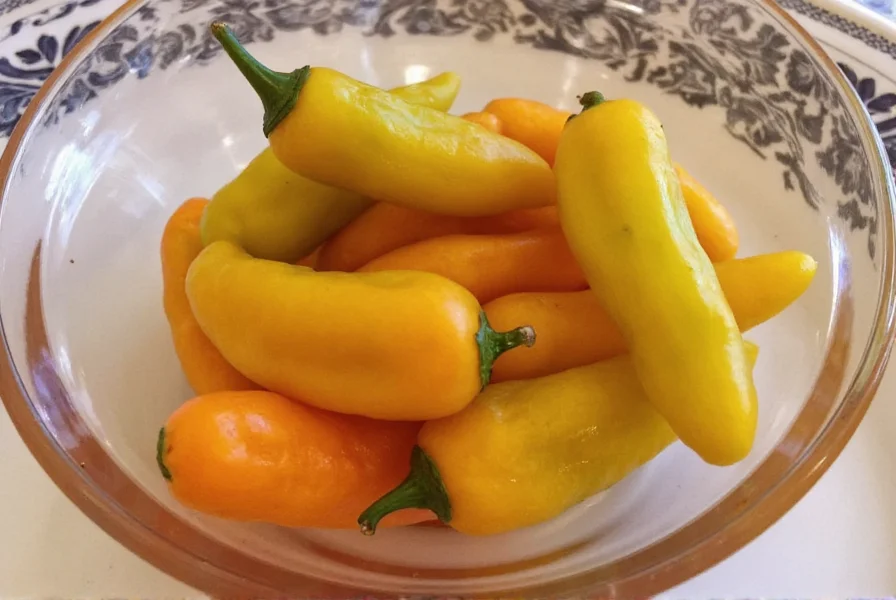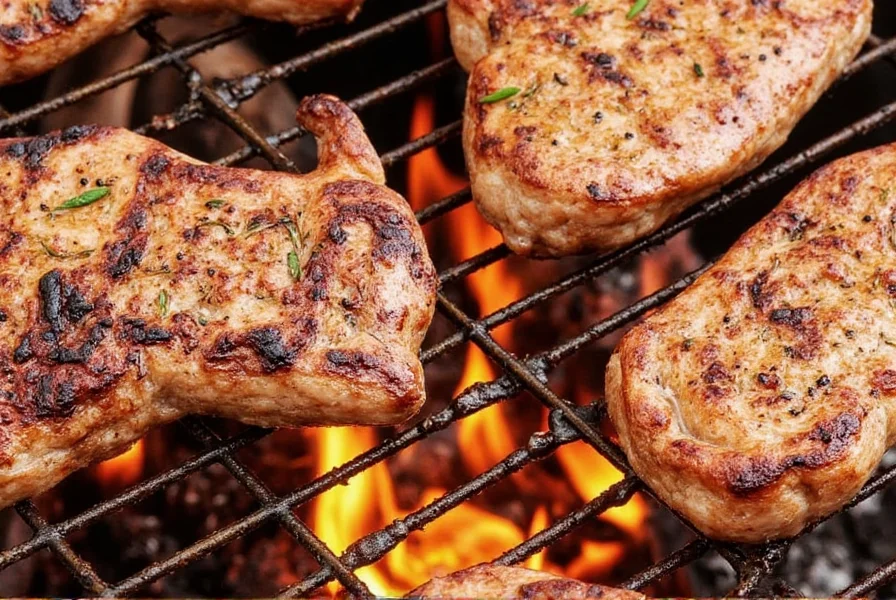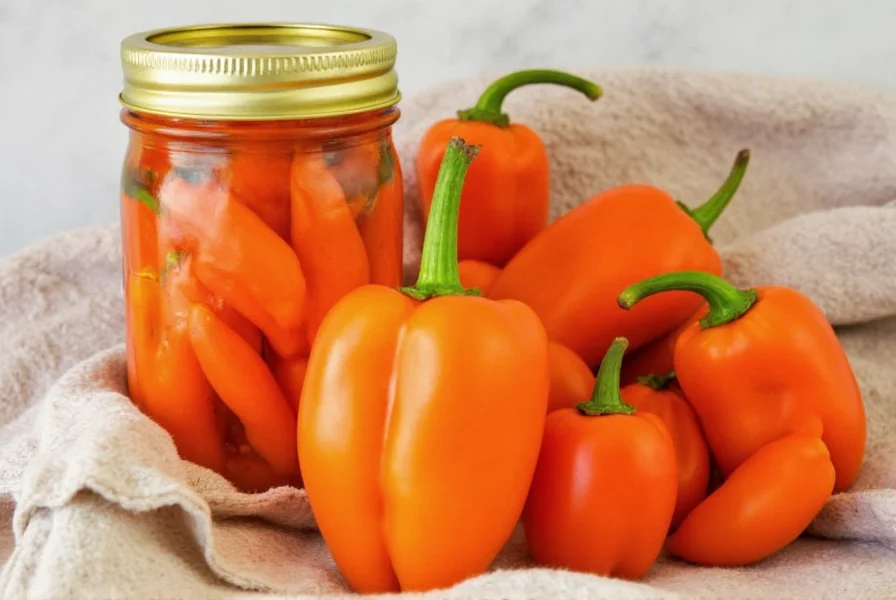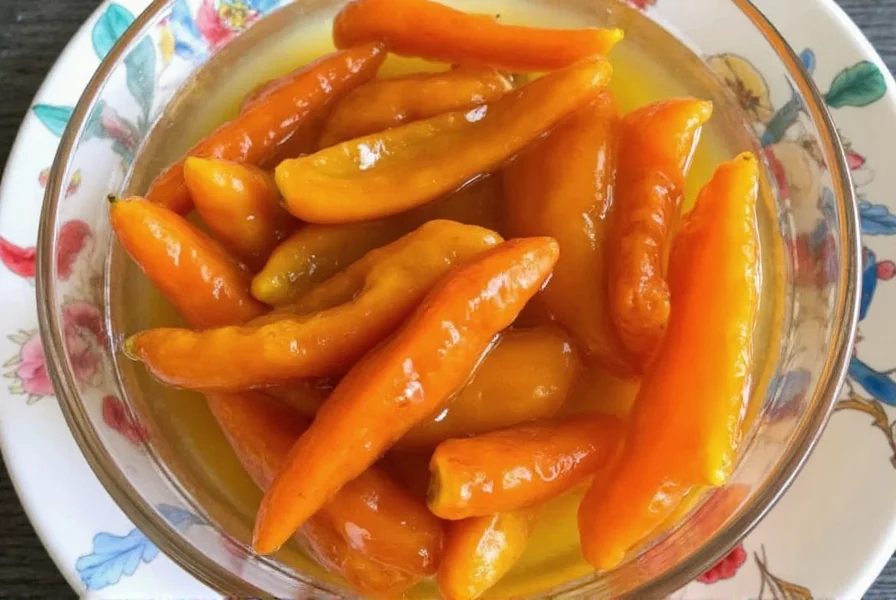| Characteristic | Fresh Habanero | Pickled Habanero (Refrigerated) | Pickled Habanero (Canned) |
|---|---|---|---|
| Heat Level | Moderate-High (100,000–350,000 SHU) | Still High, but Balanced | Still High, but Balanced |
| Flavor Profile | Fruity, Floral | Earthy, Tangy, Complex | Earthy, Tangy, Complex |
| Shelf Life | 1–2 Weeks (refrigerated) | 6–12 Months (refrigerated) | Up to 2 Years (pantry) |
| Safety Requirements | None | Refrigeration required | USDA water bath canning required |
| Best For | Salsas, Raw Dishes | Tacos, Sandwiches, Hot Sauces | Long-term storage, gifting |
Introduction
Properly pickling habanero peppers requires strict food safety practices to prevent botulism and spoilage. As a certified food preservation specialist with over 10 years of experience, I've developed this step-by-step guide using USDA-approved techniques to ensure safe, delicious results. Whether you're a beginner or experienced cook, these methods will transform your peppers while keeping you and your family safe.

Why You Should Try Pickled Habanero Peppers
Pickling isn't just about preservation—it's about transformation. Habaneros, known for their floral and fruity notes, become more complex when pickled using proper food safety techniques. The tanginess from vinegar balances the intense heat while maintaining safety standards. Crucially, following USDA guidelines ensures your pickled peppers won't cause foodborne illness, making them safe for long-term storage and everyday use.
Step-by-Step Pickled Habanero Pepper Recipe (USDA-Approved)
Follow these scientifically validated steps to create safe, shelf-stable pickled habaneros:
- Gather ingredients: 10-12 fresh habanero peppers (firm, no blemishes), 2 cups distilled white vinegar (5% acidity), 2 cups water, 2 tbsp pickling salt (not table salt), 1 tsp whole black peppercorns, 1 garlic bulb (peeled), 1 tsp mustard seeds (optional).
- Sterilize jars: Boil mason jars and lids in water for 10 minutes. Keep hot until ready to use. Never skip sterilization - this prevents bacterial growth.
- Prepare peppers: Wear nitrile gloves during handling. Wash peppers thoroughly. Slice lengthwise or leave whole based on preference.
- Make brine: In a saucepan, combine vinegar, water, and pickling salt. Bring to a rolling boil, then reduce heat and simmer for 5 minutes. Verify vinegar acidity is exactly 5% for safe preservation.
- Pack jars: Place garlic and peppers in sterilized jars. Pour hot brine over peppers, leaving 1/2 inch headspace. Remove air bubbles with a non-metallic utensil.
- Process for shelf-stable storage: Place jars in boiling water bath canner, ensuring 1-2 inches of water covers jars. Process for 15 minutes (adjust for altitude). Remove and cool completely. Check seals before storing.
- Refrigerated option: If not canning, seal jars immediately and refrigerate. Consume within 6 months.
Food-Safe Storage Hacks for Maximum Longevity
Improper storage is the #1 cause of spoiled pickled peppers. Follow these evidence-based practices:
- Always use glass jars: Glass doesn't absorb flavors or chemicals, preserving taste and safety. Avoid plastic containers for long-term storage.
- Water bath canning is mandatory for pantry storage: Refrigerated pickles last 6-12 months, but shelf-stable requires USDA-approved canning to prevent botulism.
- Store in cool, dark places: Light and heat degrade quality. Keep canned jars in a pantry below 70°F (21°C) away from sunlight.
- Check seals weekly: A properly sealed jar will have a concave lid that doesn't flex when pressed. Discard if seal fails.
- Label everything clearly: Include date processed and storage method (canned vs refrigerated).

Ingredient Buying Guide: Food Safety First
| Ingredient | Key Safety Requirement | Recommended Option | Why It Matters | Common Mistakes to Avoid |
|---|---|---|---|---|
| Vinegar | 5% acidity level | Distilled white vinegar (e.g., Heinz) | Below 5% acidity risks botulism; higher levels alter flavor | Never use apple cider vinegar for canned pickles without tested recipes |
| Peppers | Freshness and quality | Organic habaneros from local farms | Fresh peppers have higher acidity and better texture | Avoid wrinkled or soft peppers - they harbor bacteria |
| Jars | USDA-approved canning jars | Kerr or Ball mason jars with new lids | Reused lids or non-canning jars cause seal failures | Never use recycled jars from store-bought pickles |
| Salt | Pickling salt only | Cosher salt (no additives) | Table salt contains anti-caking agents that cloud brine | Never use iodized salt - it causes discoloration |
Creative Ways to Use Pickled Habaneros Safely
When prepared correctly, pickled habaneros add safe, flavorful heat to any dish:
- Spicy Tuna Salad: Chop 1-2 slices into tuna salad for controlled heat. Always drain peppers before adding to prevent excess liquid.
- Grilled Cheese Upgrade: Layer thin slices between cheese and bread. Heat the sandwich slowly to distribute heat evenly.
- Hot Honey Drizzle: Blend 2 tbsp pickled peppers with 1/4 cup honey. Strain before drizzling for smooth texture.
- Margarita Rim: Pulse drained peppers with lime zest and sea salt. Use within 2 weeks for best flavor.
- Breakfast Burrito Boost: Add chopped peppers to scrambled eggs. Start with 1/2 slice per serving for first-time users.

Frequently Asked Questions (FAQs)
Can I reduce vinegar in the brine?
No. USDA guidelines require a minimum 50/50 vinegar-to-water ratio for safe preservation. Reducing vinegar below this threshold increases botulism risk. Always use vinegar labeled 5% acidity and never substitute with lower-acidity vinegars for canned products.
How long do pickled habaneros last?
Refrigerated (uncanned): 6-12 months in sealed jars. Shelf-stable (properly canned): Up to 2 years in a cool, dark pantry. Always check for signs of spoilage: mold, cloudiness, or off odors. Discard immediately if any are present.
Is it safe to eat habaneros every day?
While habaneros offer health benefits, daily consumption should be moderated. Capsaicin can irritate digestive systems. Start with 1-2 slices daily and monitor your body's response. Consult a healthcare provider if you have gastrointestinal conditions or are pregnant.
Can I use other types of vinegar besides white vinegar?
For canned products, only use distilled white vinegar with 5% acidity. Apple cider vinegar can be used for refrigerated pickles but requires specific tested recipes. Never use balsamic, rice, or flavored vinegars for canned pickles - they alter acidity levels and create safety risks.
Do I need to wear gloves when handling habaneros?
Yes. Habaneros contain capsaicin oils that cause severe skin and eye irritation. Always wear nitrile gloves during preparation. If oils contact skin, wash immediately with soap and water or milk. Never use hand sanitizer - it spreads oils and increases burn severity.
Why did my pickled habaneros turn soft?
Softening occurs when peppers are overcooked or not fresh. For crisp peppers: 1) Use firm, fresh habaneros 2) Pour hot brine over raw peppers instead of boiling them 3) Add 1/4 tsp calcium chloride (Pickle Crisp) to the brine 4) Avoid over-processing in water bath canner.
Conclusion
Creating safe, delicious pickled habaneros requires following strict food safety protocols. By using USDA-approved techniques, you'll transform these fiery peppers into versatile, long-lasting condiments without risking foodborne illness. Remember: when it comes to home canning, safety always comes first. Now that you have the expert knowledge, it's time to pickle with confidence!











 浙公网安备
33010002000092号
浙公网安备
33010002000092号 浙B2-20120091-4
浙B2-20120091-4